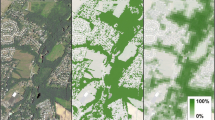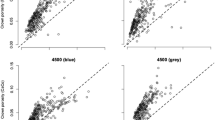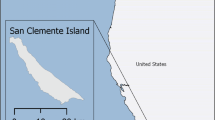Abstract
Wyoming’s Green Mountain Common Allotment is public land providing livestock forage, wildlife habitat, and unfenced solitude, amid other ecological services. It is also the center of ongoing debate over USDI Bureau of Land Management’s (BLM) adjudication of land uses. Monitoring resource use is a BLM responsibility, but conventional monitoring is inadequate for the vast areas encompassed in this and other public-land units. New monitoring methods are needed that will reduce monitoring costs. An understanding of data-set relationships among old and new methods is also needed. This study compared two conventional methods with two remote sensing methods using images captured from two meters and 100 meters above ground level from a camera stand (a ground, image-based method) and a light airplane (an aerial, image-based method). Image analysis used SamplePoint or VegMeasure software. Aerial methods allowed for increased sampling intensity at low cost relative to the time and travel required by ground methods. Costs to acquire the aerial imagery and measure ground cover on 162 aerial samples representing 9000 ha were less than $3000. The four highest correlations among data sets for bare ground—the ground-cover characteristic yielding the highest correlations (r)—ranged from 0.76 to 0.85 and included ground with ground, ground with aerial, and aerial with aerial data-set associations. We conclude that our aerial surveys are a cost-effective monitoring method, that ground with aerial data-set correlations can be equal to, or greater than those among ground-based data sets, and that bare ground should continue to be investigated and tested for use as a key indicator of rangeland health.



Similar content being viewed by others
References
Abel N, Stocking M (1987) A rapid method for assessing rates of soil erosion from rangeland: an example from Botswana. Journal of Range Management 40:460–466
Bennett LT, Judd TS, Adams MA (2000) Close-range vertical photography for measuring cover changes in perennial grasslands. Journal of Range Management 53:634–641
Blaschke T, Strobl J (2001) What’s wrong with pixels? Some recent developments interfacing remote sensing and GIS: GeoBIT/GIS, 6:12–17
BLM (Bureau of Land Management) (1997) Standards for healthy rangelands and guidelines for livestock grazing management. booklet BLM/WY/AE-97–023 + 1020, USDI, Cheyenne, Wyoming
Booth DT (1974) Photographic remote sensing techniques for erosion evaluations. MS Thesis, Univ. Nevada, Reno
Booth DT, Tueller PT (2003) Rangeland monitoring using remote sensing. Journal of Arid Land Research and Management 17:455–478
Booth DT, Cox SE, Louhaichi M, Johnson DE (2004) Lightweight camera stand for close-to-earth remote sensing. Journal of Range Management 57:675–678
Booth DT, Cox SE, Fifield C, Phillips M, Williamson N (2005a) Image analysis compared with other methods for measuring ground cover. Arid Land Research and Management 19:91–100
Booth DT, Cox SE, Johnson DE (2005b) Detection-threshold calibration and other factors influencing digital measurements of bare ground. Rangeland Ecology and Management 58:598–604
Booth DT, Cox SE (2006) Very-large scale aerial photography for rangeland monitoring. Geocarto International 21:27–34
Booth DT, Cox SE, Berryman RD (2006a) Precision measurements from very large scale aerial digital imagery using ImageMeasurement, Laserlog, and Merge software applications. Remote Sensing of Environment 112:293–307
Booth DT, Cox SE, Meikle TW, Fitzgerald C (2006b) The accuracy of ground cover measurements. Rangeland Ecology and Management 59:179–188
Booth DT, Cox SE, Berryman RD (2006c) Point sampling digital imagery using ‘SamplePoint’. Environmental Monitoring and Assessment 123:97–108
Claveran RA (1966) Two modifications to the vegetation photographic charting method. Journal of Range Management 19:371–373
Comer RP, Kinn G, Light D, Mondello C (1998) Talking digital. Photogrammetric Engineering and Remote Sensing 64:1139–1142
Cook CW, Stubbendieck J (1986) Range research: basic problems and techniques. Society for Range Management, Denver, Colorado, p 317
Cooper WS (1924) An apparatus for photographic recording of quadrats. J Ecol 12:317–321
Everitt JH, Escobar DE, Davis MR (1995a) Using remote sensing for detecting and mapping noxious plants. Weed Abstracts 44:639–649
Everitt JH, Anderson GL, Escobar DE, Davis MR, Spencer NR, Andrascik RJ (1995b) Use of Remote sensing for detecting and mapping leafy spurge (Euphorbia esula). Weed Technology 9:599–609
Farquhar B (2003) BLM’s Bennett hears Green Mountain gripes. Casper Star-Tribune, Thursday, March 13
Hadak M (2002) Green Mountain Common Allotment managed by Bureau of Land Management (BLM) Lander Field Office, http://www.mikehudak.com/PhotoEssays/GreenMtn2001VS/GreenMtn2001.html
Johnson DE, Vulfson M, Louhaichi M, Harris NR (2003) VegMeasure Version 1.6 User’s Manual. Department of Rangeland Resources, Oregon State University, Corvallis, Oregon, p 50
Kaiser J (Director, Rangeland Management, US Forest Service) (2005) Letter to Dennis Child, Co-Chair, Sustainable Rangelands Roundtable, 7 October, concerning a Noble Foundation meeting of BLM, NRCS, USGS and FS representatives to discuss interagency agreement of indicators to be used in rangeland assessments. File code 2200, Washington, DC
Interagency Technical Team (ITT) (1996) Sampling Vegetation Attributes, Interagency Technical Reference, Report No. BLM/RS/ST-96/002 + 1730. Denver, CO: U.S. Department of the Interior, Bureau of Land Management-National Applied Resources Science Center. Available online at: http://www.blm.gov/nstc/library/pdf/samplveg.pdf. Accessed 2 Nov. 2005
Laliberte AS, Rango A, Herrick JE, Fredrickson EL (2007a) An object-based image analysis approach for determining fractional cover of senescent and green vegetation with digital plot photography. Journal of Arid Environments 69:1–14
Laliberte AS, Fredrickson EL, Rango A (2007b) Combining decision trees decision trees with hierarchical object-oriented image analysis for mapping arid rangelands. Photogrammetric Engineering and Remote Sensing 73:197–207
Lobo A, Moloney K, Chiariello N (1998) Fine-scale mapping of a grassland from digitized aerial photography: an approach using image segmentation and discriminant analysis. Journal of Remote Sensing 19:65–84
Louhaichi M, Borman MM, Johnson DE (2001) Spatially located platform and aerial photography for documentation of grazing impacts on wheat. Geocarta 16:63–68
National Research Council (NRC) (1994) Rangeland health. National Academy Press, Washington, DC, p 180
Oosting HJ (1956) The study of plant communities. WH Freeman and Co, San Francisco, California, p 440
Owens MK, Gardiner HG, Norton BE (1985) A photographic technique for repeated mapping of rangeland plant populations in permanent plots. Journal of Range Management 38:231–232
Paruelo JM, Golluscio RA (1994) Range assessment using remote sensing in Northwest Patagonia (Argentina). Journal of Range Management 47:498–502
Pickup G, Bastin GN, Chewings VH (1994) Remote-sensing-based condition assessment for nonequilibrium rangelands under large-scale commercial grazing. Ecological Applications 4:497–517
Ritchie JC, Everitt JH, Escobar DE, Jackson TJ, Davis MR (1992) Airbourne laser measurements of rangeland canopy cover and distribution. Journal of Range Management 45:189–193
Rowland JW, Hector JM (1934) A camera method for charting quadrats. Nature 133:179
Seefeldt SS, Booth DT (2006) Measuring plant cover in sagebrush steppe rangelands: a comparison of methods. Environmental Management 37:703–711
Society for Range Management, Task Group on Unity in Concepts and Terminology (1995) New concepts for assessment of rangeland condition. Journal of Range Management 48:271–282
Tueller PT (1989) Remote sensing technology for rangeland management applications. Journal of Range Management 42:442–453
Tueller PT (1996) Near-earth monitoring of range condition and trend. Geocarto 11:53–62
Tueller PT, Lorain G, Kipping K, Wilkie C (1972) Methods for measuring vegetation changes on Nevada rangelands. Agricultural Experiment Station. University of Nevada, Reno
VanAmburg LK, Booth DT, Weltz MA, Trlica MJ (2005) A laser point frame to measure cover. Rangeland Ecology and Management 58:598–604
Wells KF (1971) Measuring vegetation changes on fixed quadrats by vertical ground stereophotography. Journal of Range Management 24:233–236
West NE (1999) Accounting for rangeland resources over entire landscapes. In: Eldridge D, Freudenberger D (eds) People and Rangelands: building the future. Proc. VI International Rangeland Congress. P.O. Box 764, Aitkenvale, Queensland 4814, Australia, pp 726–736
Acknowledgments
This research was funded in part by a grant from the Wyoming State Office of the Bureau of Land Management to D.T. Booth, and in part by a grant from the USDA Small Business Innovation Research (SBIR) program, grant number 2004-33610-14343, to T. W. Meikle. We thank C. Fitzgerald and John Likins and his associates at the Lander Field Office, USDI-Bureau of Land Management, and Joe Nance, Cloudstreet Airsports, Ft Collins, CO, for their efforts in data collection. We thank A. S. Laliberte, D. A. Pyke, and A. Rango for reviewing this article.
Author information
Authors and Affiliations
Corresponding author
Rights and permissions
About this article
Cite this article
Booth, D.T., Cox, S.E., Meikle, T. et al. Ground-Cover Measurements: Assessing Correlation Among Aerial and Ground-Based Methods. Environmental Management 42, 1091–1100 (2008). https://doi.org/10.1007/s00267-008-9110-x
Received:
Accepted:
Published:
Issue Date:
DOI: https://doi.org/10.1007/s00267-008-9110-x




